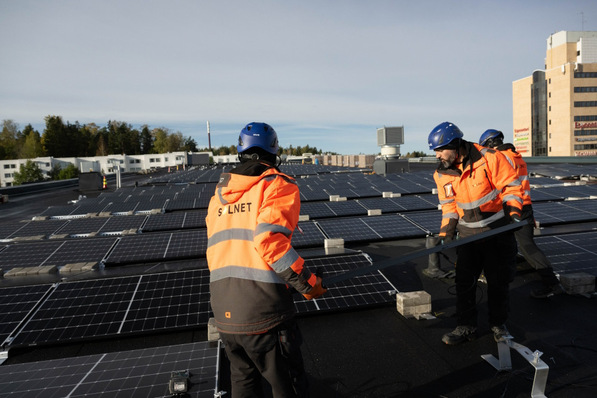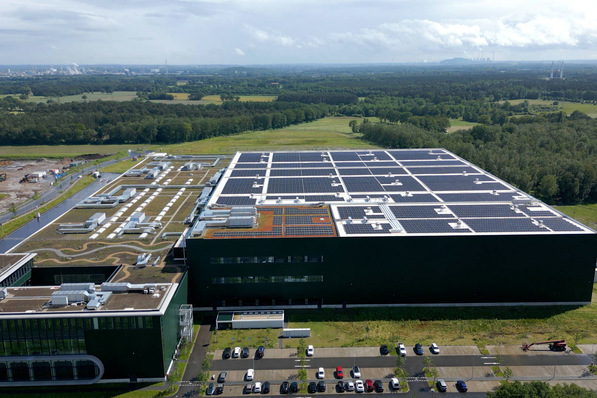At the Intersolar in Munich, you introduced the Resu 6.4 EX, a new storage system. How have sales been progressing?
We had marketed the predecessor model Resu 5.0 in Europe the previous year. This new storage unit is a big step forward, that much is clear from the sales figures. The Resu 6.4 EX has a capacity of 6.4 kilowatt hours and can be extended using two battery packs of 3.2 kilowatt hours each, resulting in a maximum capacity of 12.8 kilowatt hours. Nevertheless, the unit is very compact and, because the basic version only weighs 60 kilograms, it is very easy to install. Any technician could do that. Even though the battery capacity really is not that small, the unit looks more like the case of a desktop computer.
Do you distribute directly to installation companies?
No, we exclusively go through retailers and other distributors. In Germany, distribution goes via wholesalers such as BayWa, EWS, ESC, Viessmann, Krannich, Nedap, Memodo or IBC Solar. In the UK, we also cooperate with suppliers of ready-for-use applications like some project developers and EPC companies. However, the UK market for storage is no comparison to what is happening in Germany. This is where the main focus of our business lies, but Italy is also slowly getting started.
How is the German market developing?
It has to be said that the market is not yet established. The relative growth from last year is strong, but in absolute figures it is not so large. But we do see a steeply rising trend. Unfortunately, this strongly depends on the developments in the PV market, which in Germany is currently languishing. We are a bit worried about that.
And in Austria or Switzerland?
We are not really seeing a market for storage in Switzerland. Not yet. And Austria will also take a little time. I think that the market in the UK and Italy will get going first. In Germany we are at a point where PV without storage makes very little sense, at least if we are talking about newly installed capacity. As we see it, there also is a market in retrofitting existing installations.
To make that possible, the storage unit would need to be compatible with as many inverters as possible. How far are you on that?
So far, our battery has been running on SMA and with Nedap’s Power Router. But we have recently successfully tested new inverters for compatibility. Among those are the products by Sungrow, Solax, Ingeteam, Victron Energy and others. We are also looking into offering more battery capacities, but that has not yet definitely been decided.
The situation in the stationary storage sector is like that in PV: The market grows if prices go down. What is your assessment of how the price of storage is going to develop?
Our first priority is bringing down the costs per kilowatt hour. So far we have managed to achieve year-on-year price reductions by double-digit percentages. The rising demand for e-mobility has clearly worked in our favour. This sector is currently going through the roof. Given certain alterations in cell chemistry, our cells can equally well be fitted to cars or storage units. They are coiled pouch cells which are very versatile in their application. We keep on working on extending the capacity of our cells. The next generation will have twice the energy density of the current one, which is a real technological leap, and that will affect prices.
Like Panasonic or Tesla, LG Chem also offers cylindrical power cells. What application were these designed for?
This is our segment for mobile applications. These kinds of cells are used in smart phones or laptop computers. Our production capacity for mobile products this year is about nine gigawatt hours. We are working towards increasing that. When it comes to cells for automotive and stationary applications, we currently build seven gigawatt hours. Our plans for capacity expansion in this area are much more aggressive. Capacity expansion alone will bring about greater leeway as far as costs are concerned.
Where are you producing the storage units?
Our factory is in South Korea and LG Chem will be among a few manufacturers that will eventually dominate the market in lithium cells – and mostly because the price essentially hinges on the ability to innovate and produce greater capacity. To have a chance in this market, you need to have international presence and have a strong brand behind you. LG is such a brand. This is also demonstrated by our solar panels, which are produced by our sister company LG Electronics. In the US we have a small factory that produces specialised battery cells for electric vehicles for the US market.
The pressure to reduce costs is mounting, not least as a result of Tesla’s activities in the US. In April 2015, Elon Musk promised to offer lithium cells at 250 US dollars per kilowatt hour. Can you keep up with that?
Let me put it this way: Tesla’s announcement just before the Intersolar has been a boon to our sector. It has also been good for sales, we all profited from the media storm. For the seven kilowatt hour Power Wall, Tesla was promising a gross wholesale price of 3,615 euros. Yes, we can keep up with that. Please understand that I cannot state concrete prices, and that our road map actually includes further price reductions. Nonetheless, I believe that the Power Wall will give fresh momentum to the market – not just in Europe.
Which market sector is showing the most promising developments or might be the one to really take off in the next few months?
I think that storage will allow small businesses and smaller industry to save a lot of money. They often pay the utilities’ commercial tariffs and have no access to tariffs for large-scale industry. That can be worthwhile, some day. It may take a little time, but we will keep an eye on the segment of storage around 20 kilowatt hours. Using racks, our batteries can be extended indefinitely, no problem. And we are already noticing that large-scale industrial storage is becoming increasingly important.
The mega battery in Feldheim has been quite the coup for you. You were able to install ten megawatts at a stroke last summer, i.e. a thousand ten-kilowatt hour storage units. Will such giant units become commonplace?
I would not say that. But such container solutions for megawatt-scale storage will be a new and interesting proposition particularly for municipal utilities. This is true even in spite of the fact that the Federal Network Agency has recently added more stringent requirements for large-scale storage to the primary control of the grid. But commercial-scale storage can still be feasible. The load-balancing power station in Feldheim is the largest stationary storage unit in Europe, and now has a medium-voltage link to a wind farm. We have since had a number of inquiries from municipal and regional utilities wanting to set up battery units. We have commercial and industrial projects in Germany, Italy, Switzerland, France and the UK.
What will the prices for storage be like in five years?
I would estimate about half of what they are today. Because in five years there will not be a single car manufacturer that is not also involved in e-mobility. Many fully electric vehicles will run on our energy cells, while hybrid cars will include our power cells. We are currently in negotiations with most major car manufacturers. At the IAA in September, Audi presented their new concept car – their response to Tesla. And we have a hand in that.
And in PV?
Of course we are hoping that the German market will recover. The current hard times are only a short-term slump. Electricity storage for private households and industry will spread from the German into other markets, we can already see this taking shape. PV without storage will then no longer make sense. Even large solar installations will be built in combination with large-scale storage units, in order to take advantage of innovative business models. However, in the long run I can only see a few manufacturers of storage units being in with a chance in such fast-paced developments. The market has to be able to function without support or subsidies. And that is not too far off. We are self-evidently making rapid progress in that direction.
(HS)
Santiago Senn has been in various positions of leadership, e.g. at Panasonic Europe, at Gehrlicher Solar and at the panel manufacturer Sunpower before he came to LG Chem in Sulzbach im Taunus in June of 2015. He is a managing director, responsible for storage cells and batteries in the European market. In Sulzbach he head of a team of five employees.







